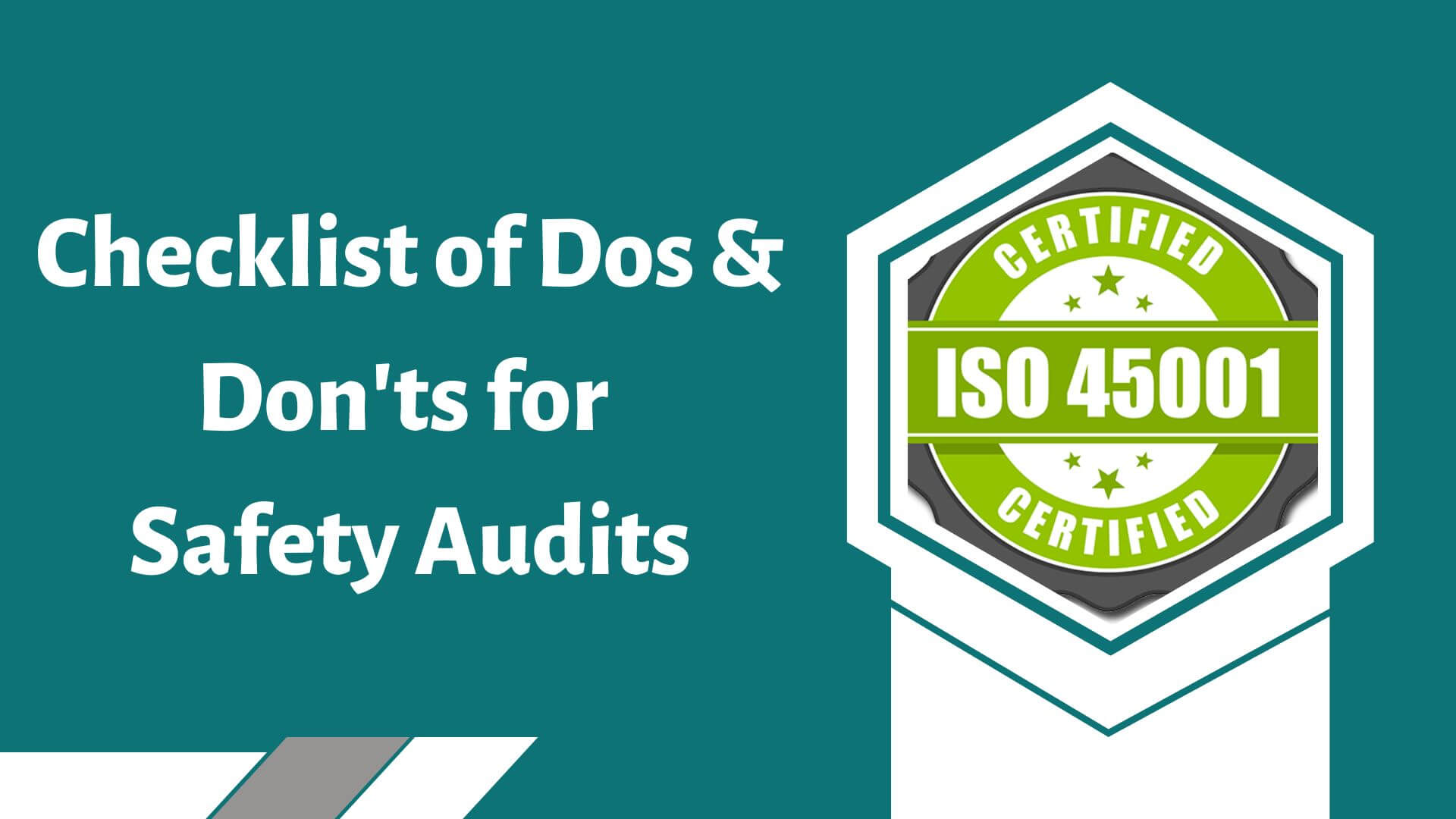Checklist of Dos and Don'ts for Safety Audits
Safety audits are critical for ensuring the safety of
employees and visitors in any organization. They assist in identifying potential risks and guarantee that the appropriate safety measures are in place. Conducting safety audits, however, can be difficult. In this blog, we will
discuss the checklist for safety audit do’s and don’ts that will help you
conduct a thorough and effective safety audit.
What are a Safety Audit and its objectives?
A safety audit is a systematic evaluation of an
organization's safety management system and safety performance, to identify
improved hazards and improved safety practices. The main objective of a safety
audit is to determine whether the safety management system is effectively controlling
the risks associated with the organization's activities and to identify areas
for improvement.
Importance of health and safety audit may include:
- Assessing how well the organization's safety rules and practices are working.
- Identifying hazards that may pose a risk to employees,
customers, or the general public.
- Determining whether the organization is complying with
applicable safety regulations and standards.
- Assessing the adequacy of safety training programs and
other safety-related programs.
- Assessing the performance of the company's safety culture.
- Locating areas where the safety management system and performance can be improved.
- Providing recommendations for corrective action to address
identified safety deficiencies.
Checklist for Safety Audit Do’s and Don’ts
Here is a checklist for Safety Audit Dos and Don'ts as per
ISO 45001:
Do's:
- Ensure that the audit is conducted by qualified and
experienced auditors who have knowledge and understanding of the ISO 45001
standard.
- Before to beginning the audit, specify its objectives and range of coverage.
- Use a checklist to ensure that all aspects of the ISO
45001 standard are covered during the audit.
- Check to see if the company has an ISO 45001-compliant occupational health and safety management system in place.
- Verify that the organization has identified and assessed
its occupational health and safety hazards and implemented appropriate
controls.
- Verify that the organization has established and
maintained documented procedures for incident investigation, and corrective and
preventive actions.
- Verify that the organization has established and
maintained documented emergency preparedness and response procedures.
- Verify that the organization has established and
maintained documented procedures for monitoring and measuring the effectiveness
of the occupational health and safety management system.
Don'ts:
- Do not rely solely on documentation or interviews with
management to determine compliance with the standard.
- Do not focus only on finding nonconformities. Instead, the audit should be a team effort to pinpoint areas that could use improvement.
- Refrain from providing advisory services or fixing the organization's issues. The auditor should remain objective and impartial.
- Do not share any confidential information about the
organization with third parties.
- Do not criticize or blame individuals or departments
during the audit. The auditor should focus on identifying opportunities for
improvement rather than assigning blame.
What are the phases of the safety audit?
The six phases of a Safety Audit are as follows:
- Planning: This phase involves defining the scope and
objectives of the safety audit, determining the resources required, and
selecting the audit team.
- Information Collection: In this phase, the audit team
collects relevant information about the safety management system, including
policies, procedures, records, and performance data.
- Field Observation: This phase involves conducting on-site
inspections and observing safety practices and conditions to identify potential
hazards and risks.
- Analysis: In this phase, the audit team analyzes the
information collected during the previous phases to evaluate the safety
management system's effectiveness and identify areas for improvement.
- Reporting: This phase involves preparing a written report
that summarizes the audit findings, identifies strengths and weaknesses in the
safety management system, and makes recommendations for improvement.
- Follow-Up: The final phase involves monitoring the
implementation of the audit recommendations and evaluating the effectiveness of
the safety management system improvements.
Type of Safety Audits as per OHSMS
Some of the types of safety audits as per OHSMS are:
- Compliance Audit: A compliance audit is conducted to
ensure that the organization is complying with relevant occupational health and
safety legislation and regulations.
- Management System Audit: A management system audit
assesses the effectiveness of the organization's OHSMS in meeting the
requirements of the standard, such as ISO 45001.
- Process Audit: A process audit evaluates the
effectiveness of specific processes that are critical to occupational health
and safety, such as hazard identification and risk assessment.
- Workplace Inspection: A workplace inspection is a visual
examination of the workplace to identify hazards and assess the adequacy of
controls to manage them.
- Incident Investigation: An incident investigation is
conducted after an incident has occurred to determine the root cause(s) and
identify corrective actions to prevent a recurrence.
- Performance Audit: A performance audit assesses the
effectiveness of the organization's occupational health and safety performance
by measuring key performance indicators (KPIs) such as injury rates,
absenteeism, and near-miss reporting.
Purpose of a Safety Audit as per ISO 45001
One of the key components of an OHSMS is the safety audit.
The purpose of a safety audit as per ISO 45001 is to evaluate the effectiveness
of an organization's occupational health and safety management system. The
safety audit helps the organization to identify areas where they are meeting
the requirements of the standard and areas where improvements can be made.
The safety audit assesses the organization's OHSMS against
the requirements of ISO 45001 and other applicable standards, regulations, and
laws. The audit also evaluates the organization's safety policies, procedures,
and practices to ensure they are being followed and are effective in reducing
or eliminating workplace hazards and risks.
It helps organizations demonstrate their commitment to
safety to stakeholders, including employees, customers, and regulatory
agencies.
Conclusion,
Safety audits are a critical component of the ISO 45001
OH&S management system. They provide a structured and systematic approach
to identify potential hazards, assess the effectiveness of control measures,
and identify opportunities for improvement. By implementing safety audits as
per ISO 45001, organizations can enhance their OH&S performance, prevent
accidents and incidents, and create a safer and healthier workplace for their
employees.
If you need any help regarding any kinds of ISO Certification feel free to contact us our Toll Free number 180030702070, Our Business advisor will explain you in details.

